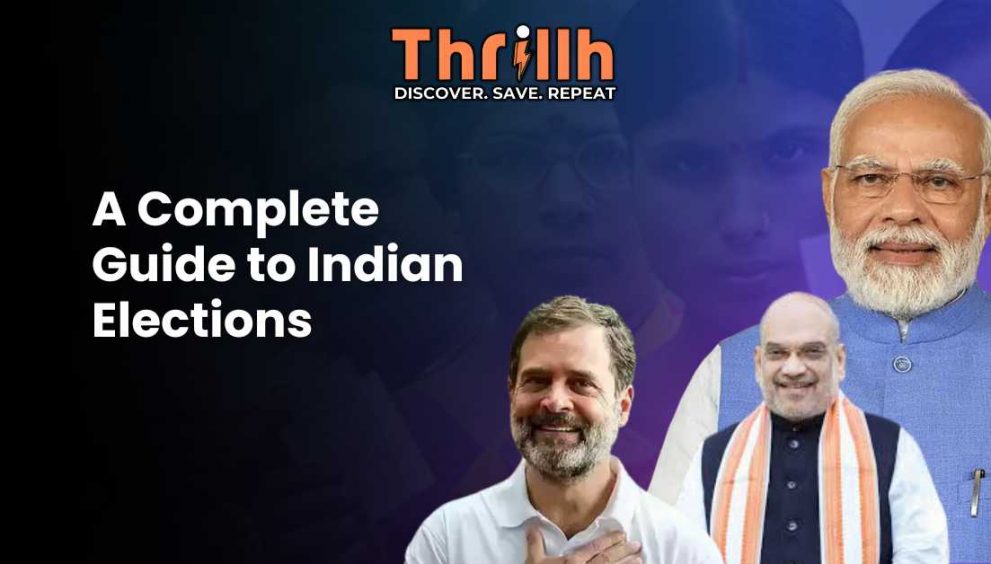Introduction to Elections
1. What is an Election?
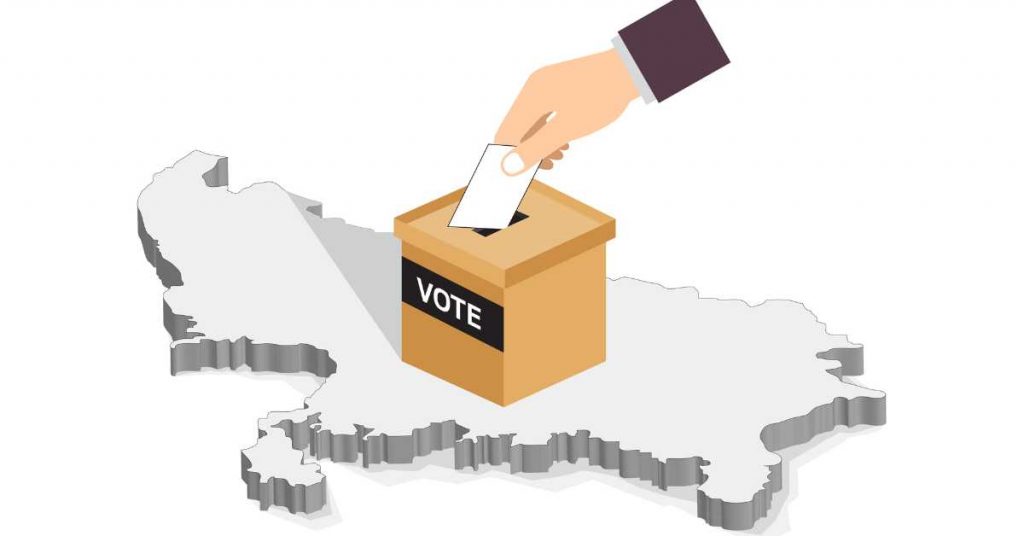
An election is a process through which people in a country or community choose their leaders or representatives. Think of it like picking a class monitor at school. Everyone votes for the person they think will do the best job. The person with the most votes wins and gets to be the leader. In a country, elections help us choose important leaders like the President, Prime Minister, or members of Parliament.
Reference:
- “Election,” Encyclopaedia Britannica
- “What is an Election?” National Democratic Institute
2. Why Do We Have Elections?
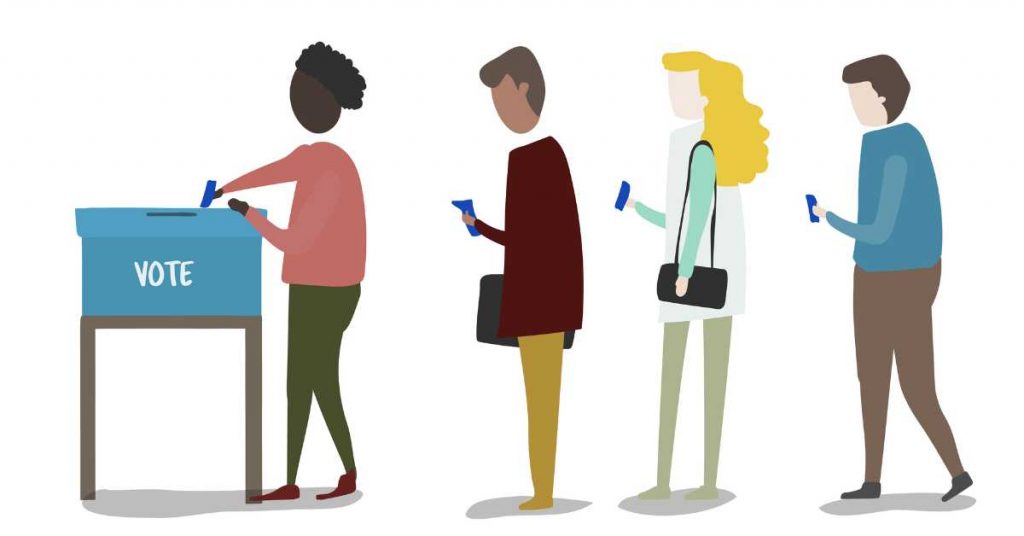
We have elections to make sure everyone has a say in who runs the country. Instead of just one person making all the decisions, elections allow everyone to have a voice. This is fair because it means the leaders are chosen by the people they will lead. Elections also help keep leaders accountable, as they need to do a good job to be re-elected.
Reference:
- “Why Do We Have Elections?” Election Commission of India
- “The Importance of Elections,” IFES
3. What is Democracy?
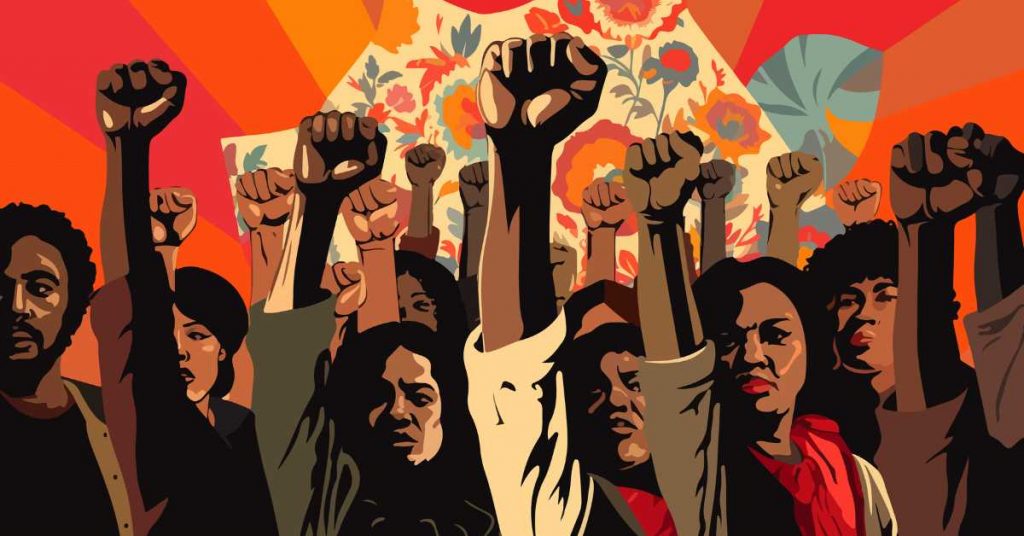
Democracy is a system of government where the people have the power to make decisions about how they are governed. The word “democracy” comes from Greek words that mean “rule by the people.” In a democracy, citizens vote in elections to choose their leaders and to make other important decisions. Elections are a key part of democracy because they allow people to express their will and influence government policies.
Reference:
- “Democracy,” Encyclopaedia Britannica
- “What is Democracy?” International IDEA
4. The Importance of Voting
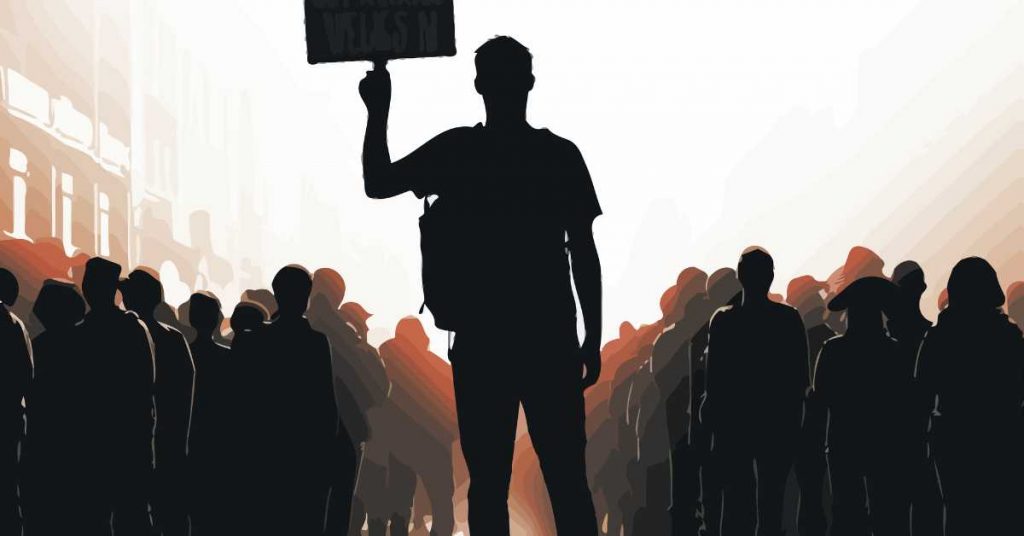
Voting is important because it is a way for people to have a say in how their country is run. Every vote counts because even a small number of votes can make a big difference in an election. When people vote, they choose leaders who represent their interests and values. If people do not vote, they miss the chance to influence decisions that affect their lives, like education, healthcare, and jobs. Voting helps to make sure the government reflects the will of the people.
Reference:
- “The Importance of Voting,” League of Women Voters
- “Why Every Vote Matters,” National Democratic Institute
The Basics of Indian Elections
What is India?
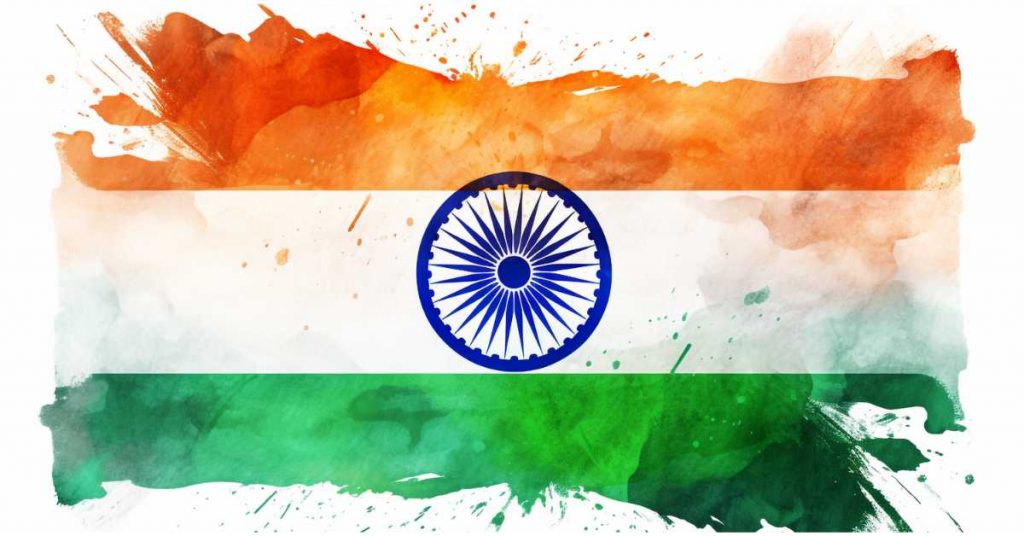
India is a large and diverse country located in South Asia. It is the seventh-largest country by land area and the second-most populous country in the world, with over 1.3 billion people. India is known for its rich history, cultural diversity, and significant contributions to science, mathematics, literature, and art.
The country is divided into 28 states and 8 union territories, each with its own unique culture and traditions. India gained its independence from British rule on August 15, 1947, and has since developed into a sovereign, socialist, secular, and democratic republic.
References:
What is the Government?
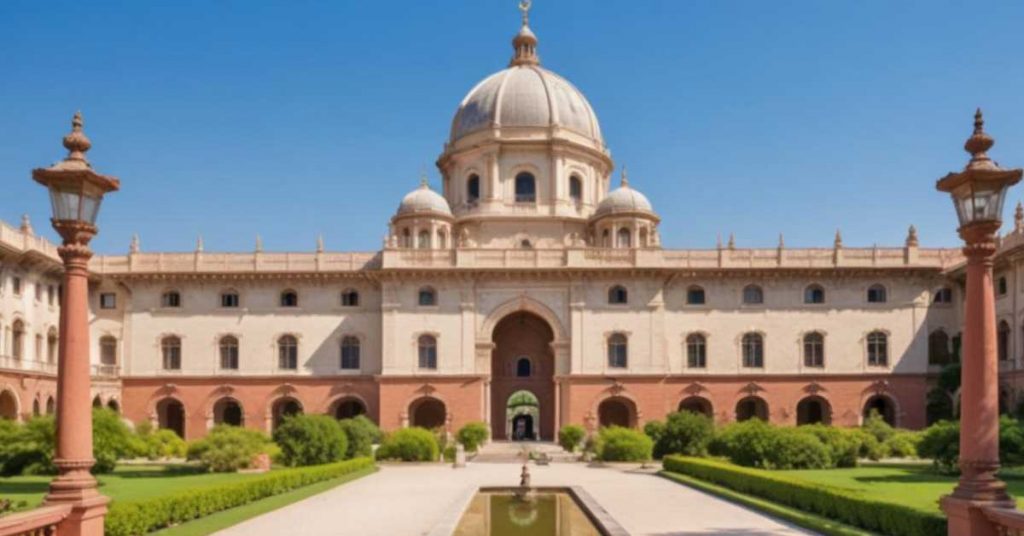
The government of India operates under a parliamentary system, which means it has a central government and state governments. The central government, also known as the Union Government, is responsible for national-level decisions, while the state governments handle regional matters. The Indian government is divided into three branches:
- Executive: Led by the President of India, this branch includes the Prime Minister and the Council of Ministers. They implement and enforce laws.
- Legislative: Comprising the Parliament of India, which includes the Rajya Sabha (Council of States) and the Lok Sabha (House of the People). They make laws.
- Judiciary: Headed by the Supreme Court of India, this branch interprets laws and ensures they are applied fairly.
References:
Who Can Vote?
In India, the right to vote is granted to every citizen who is 18 years of age or older. This right is universal, meaning it does not discriminate based on race, religion, gender, or economic status. To vote, citizens must register as voters in their constituency. Voting is a fundamental part of democracy, allowing citizens to choose their representatives and influence government decisions.
References:
A Brief History of Indian Elections

Since gaining independence in 1947, India has held regular elections to ensure a democratic process. The first general elections were held in 1951-52, which established India as the world’s largest democracy. These elections were a massive undertaking, involving nearly 173 million voters.
Over the years, India’s electoral process has evolved with advancements in technology and an increase in voter participation. Today, elections in India are conducted using Electronic Voting Machines (EVMs) to ensure efficiency and accuracy.
References:
The Role of the President and Prime Minister
The President:
The President of India is the ceremonial head of state and the supreme commander of the Indian Armed Forces. The President’s role is largely symbolic, with most executive powers being exercised by the Prime Minister. The President is elected by an Electoral College, which includes members of both houses of Parliament and the legislative assemblies of the states and union territories. The term of office is five years.
The Prime Minister:
The Prime Minister is the head of government and holds the most significant executive authority in India. The Prime Minister is appointed by the President, usually from the majority party in the Lok Sabha, and leads the Council of Ministers. The Prime Minister’s responsibilities include setting government policies, making important national decisions, and representing India internationally.
References:
How Elections Work in India?
The Election Process
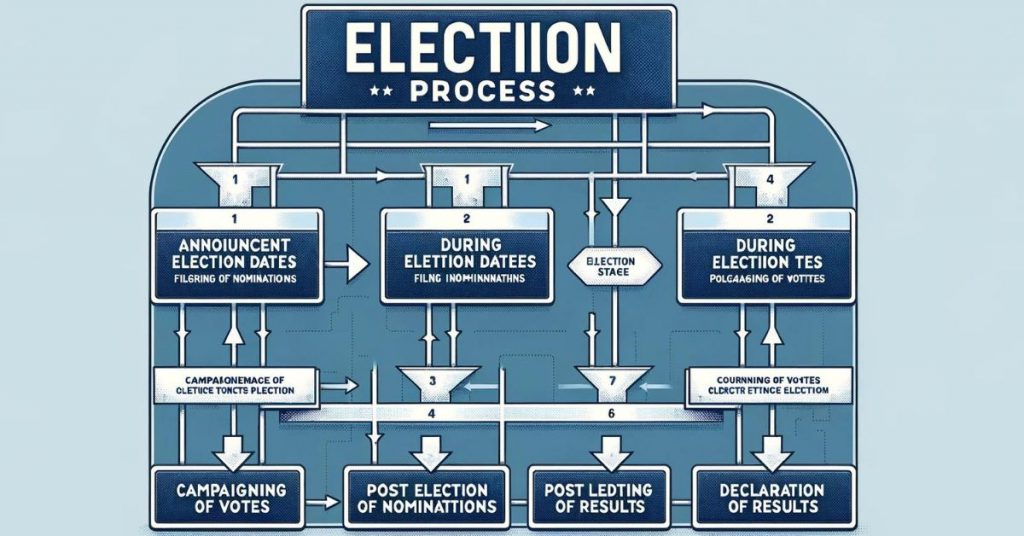
The election process in India is a well-organized, multi-step procedure that ensures free and fair elections. Here’s a breakdown of the key steps involved:
- Announcement of Election Dates: The Election Commission of India (ECI) announces the schedule for the elections, including the dates for polling, filing nominations, and counting votes.
- Filing of Nominations: Candidates who wish to contest the elections must file their nomination papers within the stipulated period. These nominations are scrutinized by election officials to ensure all eligibility criteria are met.
- Campaigning: Once nominations are accepted, candidates and political parties begin their campaigns. This period is used to connect with voters, present manifestos, and outline future policies.
- Polling: On the designated polling day(s), voters cast their ballots at polling stations. The voting process is overseen by trained officials to ensure it is conducted smoothly.
- Counting of Votes: After polling concludes, votes are counted. The process is transparent and often monitored by party representatives and observers.
- Declaration of Results: The final results are announced by the ECI, declaring the winners for each seat.
The election process is designed to be inclusive, ensuring that every eligible citizen has the opportunity to participate in the democratic process.
Reference: Election Commission of India
Who Organizes the Elections?
The Election Commission of India (ECI) is the autonomous constitutional authority responsible for administering election processes in India at both national and state levels. Established on January 25, 1950, the ECI ensures that elections are conducted in a free, fair, and transparent manner.
The ECI is headed by the Chief Election Commissioner (CEC) and assisted by two Election Commissioners. Together, they oversee all aspects of the electoral process, from preparing electoral rolls to the actual conduct of polling and counting of votes. The ECI also sets guidelines for election conduct, monitors campaign financing, and addresses election-related disputes.
Reference: Election Commission of India
How Do People Vote?
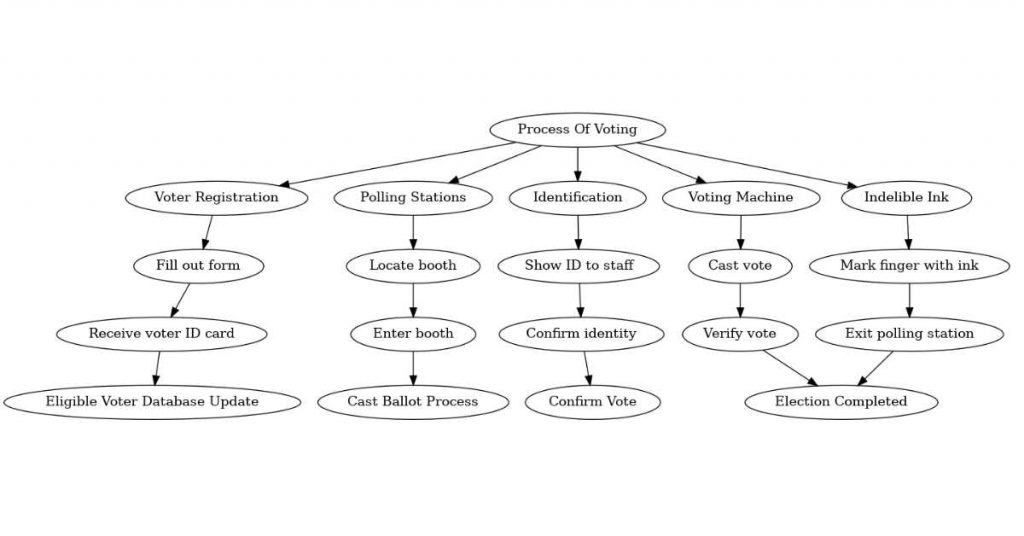
Voting in India is a straightforward process designed to be accessible to all eligible citizens. Here’s how it works:
- Voter Registration: Citizens must first register to vote, ensuring their names are on the electoral roll. This can be done online or through designated voter registration centers.
- Polling Stations: On election day, voters go to their assigned polling stations. These are often set up in schools, community centers, or other public buildings.
- Identification: Voters must present a valid identification document, such as a voter ID card, to the polling officials.
- Voting Machine: India uses Electronic Voting Machines (EVMs) to record votes. Voters press a button next to the name and symbol of their preferred candidate.
- Indelible Ink: To prevent multiple voting, a mark of indelible ink is applied to the voter’s finger after they cast their vote.
This system ensures that the voting process is quick, efficient, and secure.
Reference: Election Commission of India
Election Symbols
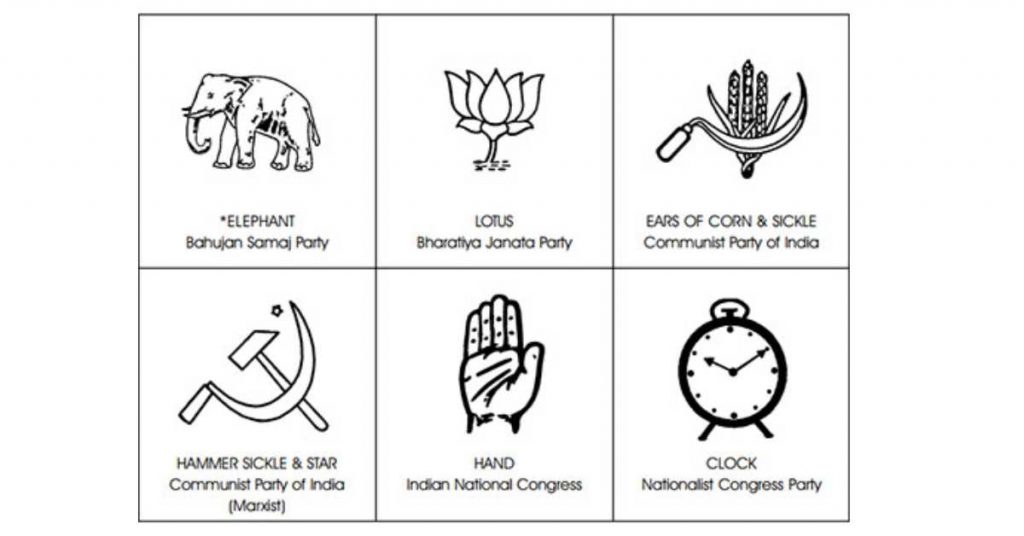
In India, each political party is assigned a unique symbol by the Election Commission. These symbols play a crucial role in helping voters, especially those who are illiterate, identify their preferred party or candidate easily.
Symbols are used on Electronic Voting Machines (EVMs) next to the names of candidates. They are also prominently displayed in election campaign materials, such as posters, banners, and advertisements.
The allocation of symbols ensures that all voters, regardless of their literacy levels, can participate fully in the electoral process, recognizing their party of choice through familiar icons.
Reference: Election Commission of India
The Model Code of Conduct
The Model Code of Conduct (MCC) is a set of guidelines issued by the Election Commission of India to regulate political parties and candidates prior to elections. The MCC aims to ensure that the elections are conducted in a free and fair manner and that the ruling party does not misuse its official position.
Key provisions of the MCC include:
No Use of Government Resources: Political parties and candidates are prohibited from using government resources for campaigning.
No Vote Buying: Offering money or other incentives to voters is strictly forbidden.
Respect for Opponents: Parties must respect their opponents and avoid making personal attacks or spreading false information.
Public Meetings: All public meetings and rallies must be pre-approved and conducted without disrupting public order.
Polling Day Conduct: On polling day, political parties and candidates must not influence or intimidate voters.
Reference: Election Commission of India
Types of Elections in India
National Elections
National elections in India are conducted to elect members to the Lok Sabha, the lower house of Parliament. The Lok Sabha consists of representatives from various constituencies across the country. These elections are held every five years, and every eligible citizen aged 18 and above can vote. The party or coalition that wins the majority of seats in the Lok Sabha forms the central government, and its leader becomes the Prime Minister.
Reference: Election Commission of India – Lok Sabha Elections
State Elections
State elections, also known as Legislative Assembly elections, are held to elect representatives to the Vidhan Sabha, the legislative assembly of each state. Each state in India is divided into constituencies, and voters in each constituency elect one representative. The party or coalition with the majority of seats forms the state government, and its leader becomes the Chief Minister. These elections are also held every five years, though not necessarily at the same time as national elections.
Reference: Election Commission of India – State Elections
Local Elections
Local elections are conducted to elect representatives to various local bodies such as municipal corporations, municipalities, panchayats, and zila parishads. These bodies handle local governance and community issues. Local elections are crucial for grassroots democracy as they empower citizens to participate in governance at the local level. These elections occur periodically, typically every five years, though the exact timing can vary by region.
Reference: Ministry of Panchayati Raj – Local Governance
Rajya Sabha Elections
The Rajya Sabha, or Council of States, is the upper house of India’s Parliament. Unlike the Lok Sabha, members of the Rajya Sabha are not directly elected by the public. Instead, they are elected by the elected members of the State Legislative Assemblies and by the members of the Electoral college for Union Territories, using a single transferable vote through proportional representation. Rajya Sabha members serve six-year terms, with one-third of the members retiring every two years.
Reference: Rajya Sabha – Election of Members
By-Elections
By-elections, or bye-elections, occur when a seat in the Lok Sabha, Vidhan Sabha, or any local body becomes vacant before the end of the usual term. This can happen due to various reasons such as the resignation or death of the sitting member. By-elections ensure that the vacancy is filled so that the representation of the constituency is not left vacant for long. The process and rules for by-elections are similar to regular elections, though they are held only for the specific vacant seat.
Reference: Election Commission of India – By-Elections
Important Parts of an Election
Candidates and Political Parties
Candidates are individuals who run for public office during an election. They can represent political parties or run as independents. Each candidate presents their vision and policies to the voters, hoping to gain their support.
Political Parties are organized groups of people who share similar political beliefs and work together to win elections and influence government policies. In India, major political parties include the Bharatiya Janata Party (BJP), Indian National Congress (INC), and many regional parties like the Aam Aadmi Party (AAP) and the All India Trinamool Congress (AITC).
Political parties play a crucial role in elections by:
- Selecting Candidates: Parties choose candidates who they believe will best represent their values and win the support of voters.
- Creating Manifestos: They outline their policies and promises in documents called manifestos, which help voters understand their agenda.
- Campaigning: Parties organize events, rallies, and advertisements to promote their candidates and policies.
References:
- Election Commission of India. “Candidates & Parties.” eci.gov.in
- Wikipedia. “Political Parties in India.” en.wikipedia.org
Campaigning: How Candidates Ask for Votes?
Campaigning is the process by which candidates and political parties promote themselves to voters. This involves various activities designed to inform, persuade, and mobilize the electorate. Campaigning strategies include:
- Public Rallies and Meetings: Candidates hold rallies to connect with large groups of people, share their policies, and motivate supporters.
- Door-to-Door Canvassing: Volunteers and candidates visit homes to speak directly with voters, address their concerns, and seek their support.
- Advertisements: Campaigns use print, television, radio, and social media ads to reach a wider audience.
- Debates: Candidates participate in debates to discuss their viewpoints on various issues and contrast their policies with those of their opponents.
Effective campaigning is crucial for gaining voter trust and increasing turnout on election day.
References:
- Election Commission of India. “Campaigning Rules.” eci.gov.in
- Wikipedia. “Election Campaign.” en.wikipedia.org
The Role of Media
Media plays a vital role in elections by providing information, analysis, and a platform for debate. Media coverage helps voters make informed decisions by:
- News Coverage: Newspapers, TV channels, and online news platforms report on election events, candidate activities, and major issues.
- Political Analysis: Experts and journalists analyze policies, debates, and campaign strategies, offering insights that help voters understand the implications of their choices.
- Opinion Polls: Media outlets conduct and publish opinion polls to gauge public sentiment and predict election outcomes.
- Fact-Checking: Media organizations fact-check statements made by candidates to ensure voters receive accurate information.
The media also provides a platform for political advertisements and public debates, contributing to a more informed electorate.
References:
- Press Council of India. “Role of Media in Elections.” presscouncil.nic.in
- Wikipedia. “Media and Elections.” en.wikipedia.org
Election Observers
Election Observers are individuals or groups who monitor the election process to ensure it is conducted fairly and transparently. Observers can be from domestic or international organizations, and their roles include:
- Monitoring Polling Stations: Observers visit polling stations to ensure voting procedures are followed correctly and that voters can cast their ballots freely.
- Assessing Campaign Fairness: They observe campaign activities to check for any violations of election laws, such as voter intimidation or misuse of government resources.
- Evaluating Election Management: Observers assess how well the election commission manages the election process, including voter registration, ballot counting, and result declaration.
Their presence helps build public confidence in the electoral process and can lead to improvements in future elections.
References:
- Election Commission of India. “Election Observers.” eci.gov.in
- Wikipedia. “Election Monitoring.” en.wikipedia.org
Voting Day: What Happens
Voting Day is the day when registered voters go to polling stations to cast their votes. Here’s what typically happens on voting day:
- Opening of Polling Stations: Polling stations open early in the morning and remain open for a set number of hours. Election staff set up voting booths and prepare for voters.
- Voter Verification: Voters arrive at their designated polling station, present their identification, and are verified against the voter list.
- Casting the Vote: Verified voters are given a ballot or directed to an electronic voting machine (EVM). They cast their vote in a private booth to ensure secrecy.
- Indelible Ink: In India, an indelible ink mark is applied to a voter’s finger after they cast their vote to prevent multiple voting.
- Closing of Polling Stations: After the voting hours end, polling stations close, and the ballots or EVMs are securely transported to counting centers.
Voting day is crucial as it is the moment when the public’s choices are recorded, leading to the formation of the new government.
References:
- Election Commission of India. “Polling Process.” eci.gov.in
- Wikipedia. “Election Day.” en.wikipedia.org
The Voting Process
Registering to Vote
Before you can vote in an election in India, you need to register as a voter. This means getting your name on the official list of eligible voters, called the electoral roll. To register, you must be at least 18 years old and a citizen of India. The registration process involves filling out a form, either online or in person, and providing proof of identity, age, and residence. Once your application is approved, your name will be added to the voter list, and you will be eligible to vote in upcoming elections.
References:
- Election Commission of India. (n.d.). How to Register to Vote
Voter ID and Voter Lists
After registering to vote, you will receive a Voter ID card, which is also known as the Elector’s Photo Identity Card (EPIC). This card has your photograph, name, and a unique identification number. It serves as proof of your eligibility to vote. The voter lists, also known as electoral rolls, are maintained and updated regularly by the Election Commission of India. These lists contain the names and details of all registered voters in each constituency.
References:
- Election Commission of India. (n.d.). Voter ID Card
- Election Commission of India. (n.d.). Electoral Roll
Going to the Polling Station
On election day, voters go to their designated polling stations to cast their votes. Polling stations are usually set up in schools, community centers, or other public buildings. Voters must carry their Voter ID card or another acceptable form of identification to the polling station. Upon arrival, voters check in with the election officials, who verify their identity and mark their finger with indelible ink to prevent multiple voting. Then, voters receive a ballot paper or access to an electronic voting machine (EVM).
References:
- Election Commission of India. (n.d.). Polling Stations
Casting Your Vote
Once inside the polling booth, voters cast their vote in secret. If using a paper ballot, voters mark their choice with a stamp or pen. If using an EVM, voters press the button next to the name or symbol of their preferred candidate. This process ensures that votes are cast confidentially and accurately. After casting the vote, voters leave the polling station, and their vote is securely recorded.
References:
- Election Commission of India. (n.d.). How to Vote
Advance Voting and Postal Ballots
For voters who cannot go to their polling stations on election day, options like advance voting and postal ballots are available. Advance voting allows certain categories of voters, such as military personnel and government employees on election duty, to vote before the official election day. Postal ballots are available for voters who are unable to visit polling stations due to physical disability, illness, or being out of the country. These voters receive their ballot papers by mail, mark their choices, and send the ballots back to the election office.
References:
- Election Commission of India. (n.d.). Postal Ballots
- Election Commission of India. (n.d.). Advance Voting
Counting the Votes and Announcing Results
How Votes are Counted?
After the voting process is complete, the counting of votes begins. This process is carefully supervised to ensure accuracy and transparency. In India, votes are typically counted using Electronic Voting Machines (EVMs), which store the votes cast by each voter.
- Opening the Machines: On the day of counting, EVMs are transported to designated counting centers. These machines are opened in the presence of candidates or their representatives, along with election officials.
- Counting Process: The stored votes in each EVM are read out and recorded. This is done booth by booth and the numbers are tallied.
- Verification: Election officials verify the recorded votes to ensure there are no discrepancies. If there are any doubts or objections from candidates, they are addressed immediately.
- Announcement: Once the counting is complete for all booths, the total votes for each candidate are calculated and verified.
The entire counting process is closely monitored by independent observers to maintain the integrity of the elections. Sources for this process include the official guidelines from the Election Commission of India and various reports on election procedures.
What Happens in the Case of a Tie?
A tie occurs when two or more candidates receive the same number of votes, resulting in no clear winner. When this rare situation arises, the outcome is decided through a simple but effective method called a “draw of lots.” This means that the winner is selected randomly, usually by drawing names out of a hat or using another impartial method.
- Draw of Lots: This is conducted by the returning officer in the presence of the candidates or their representatives. It ensures fairness and transparency in deciding the winner.
- Legal Framework: The process is governed by specific laws and guidelines provided by the Election Commission of India, which ensures that the method used is fair and unbiased.
This method is a standard practice in many democratic countries and is outlined in the election regulations to handle such exceptional cases. For detailed information, refer to the Representation of the People Act, 1951.
Recounts and Disputes
Recounts and disputes are an essential part of the electoral process to address any concerns regarding the accuracy of the vote count.
- Recounts: A recount can be requested by any candidate if they believe there has been an error in the counting process. The request must be made before the final declaration of results. The returning officer then conducts a recount in the presence of the candidates or their representatives.
- Procedure: The votes are recounted in the same manner as the initial count. If discrepancies are found, the corrected totals are used.
- Grounds for Recount: Recounts are typically granted if the margin of victory is very small or if there are reports of irregularities.
- Disputes: If there are serious allegations of malpractice or fraud, candidates can file an election petition in the court. This legal process can result in a re-examination of the entire electoral process in the contested constituency.
- Legal Process: The court reviews the evidence and can order a fresh election if it finds substantial proof of wrongdoing.
The recount process and handling of disputes are detailed in the Election Commission’s guidelines and various legal frameworks. References include the Election Commission of India’s manual on election procedures and relevant sections of the Representation of the People Act, 1951.
Declaring the Winners
Once the counting of votes is complete and any recounts or disputes are resolved, the final step is the declaration of winners.
- Official Declaration: The returning officer officially declares the candidate with the highest number of votes as the winner. This announcement is made publicly and documented in official records.
- Certificates of Election: The winning candidates are issued certificates of election, formally recognizing their victory and authorizing them to take office.
- Public Announcement: The results are also published by the Election Commission of India and shared with the media for public dissemination.
The declaration of winners marks the conclusion of the electoral process, leading to the formation of the government or the assembly. This process ensures that the election results are transparent and credible. For more detailed guidelines, refer to the Election Commission of India’s handbook on election results and official documentation.
These steps are based on established electoral practices and legal requirements in India, as documented by the Election Commission of India and various legal texts on election laws.
After the Elections
Forming the Government
Once the election results are announced and the winners are declared, the process of forming the government begins. The party or coalition with the majority of seats in the legislature is invited to form the government. In India, this means securing at least 272 seats in the Lok Sabha, the lower house of Parliament.
The leader of the majority party or coalition is usually appointed as the Prime Minister. This person is formally invited by the President of India to form the government. The Prime Minister then selects other members of the cabinet, who are responsible for different government departments and functions.
Reference:
- Election Commission of India: How the Government is Formed
- Indian Parliament: The Process of Government Formation
The Role of the Opposition
The opposition is made up of parties and members who did not win enough seats to form the government. The role of the opposition is crucial in a democracy. They are responsible for questioning and scrutinizing the actions and policies of the government, ensuring transparency and accountability.
The leader of the largest party not in government typically becomes the Leader of the Opposition. This person plays a key role in providing alternative policies and ideas, and in holding the government accountable through debates and discussions in Parliament.
Reference:
- Indian Parliament: The Role of the Opposition
- Lok Sabha Secretariat: Functions of the Opposition
Oath of Office
Before starting their official duties, elected leaders take an oath of office. This is a formal ceremony where they swear to uphold the Constitution and perform their duties faithfully. In India, the President administers the oath to the Prime Minister and Union Ministers, while Governors administer the oath to the Chief Ministers and State Ministers.
The oath ceremony is a significant event, symbolizing the leaders’ commitment to serving the nation and its people. It usually takes place at the Rashtrapati Bhavan for the central government or at the respective Raj Bhavan for state governments.
Reference:
- President of India: Oath of Office
- Ministry of Home Affairs: Procedure for Oath Taking
Government Formation at State and Local Levels
Government formation at the state level follows a similar process to the national level. The party or coalition with the majority in the state legislative assembly is invited to form the government. The leader of this majority is appointed as the Chief Minister by the Governor. The Chief Minister then selects their cabinet members, who are responsible for various state departments.
At the local level, elections are held for bodies like municipalities and panchayats. The elected members choose their leaders, such as the Mayor or Sarpanch, who oversee local governance and development activities.
Reference:
- State Election Commissions: State Government Formation
- Ministry of Panchayati Raj: Local Government Formation
Special Features of Indian Elections
Electronic Voting Machines (EVMs)
Electronic Voting Machines (EVMs) are the cornerstone of India’s electoral process, introduced to enhance efficiency and accuracy in voting. These machines have been extensively used since the late 1990s, replacing traditional paper ballots. EVMs are designed to store votes electronically and provide a secure and tamper-proof method of voting.
Reference: Election Commission of India
Ensuring Fair and Free Elections
The Election Commission of India (ECI) plays a crucial role in ensuring fair and free elections by implementing strict guidelines and monitoring the electoral process. Measures such as voter education campaigns, voter identification, and the deployment of observers help maintain the integrity of the electoral process and prevent malpractices. The ECI also collaborates with law enforcement agencies to address any issues of coercion or intimidation during the electoral process.
Reference: Election Commission of India
Security Measures
Security during elections is paramount to ensure the safety of voters, election officials, and candidates. Various measures are implemented to maintain law and order, including the deployment of security personnel at polling stations and sensitive areas, conducting security assessments, and utilizing technology for surveillance and monitoring. Additionally, the Election Commission works closely with state and central agencies to coordinate security arrangements and respond promptly to any security threats or incidents.
Reference: Election Commission of India
Role of Technology in Elections
Technology plays a significant role in modern Indian elections beyond just electronic voting machines. Voter registration systems, online voter ID verification, and the use of biometric authentication have streamlined the electoral process and enhanced transparency. Social media platforms are also utilized for voter outreach and engagement, while data analytics tools help analyze voter trends and demographics. However, the use of technology also raises concerns about cybersecurity and data privacy, prompting the Election Commission to implement robust safeguards.
Reference: Election Commission of India
Important Election Rules
Indian elections are governed by a set of rules and regulations outlined by the Election Commission to ensure the smooth conduct of elections. These rules cover various aspects such as candidate eligibility criteria, campaign finance regulations, polling procedures, and code of conduct for political parties and candidates. Adherence to these rules is essential for maintaining the integrity and fairness of the electoral process.
Reference: Election Commission of India
These special features underscore the complexity and thoroughness of the Indian electoral system, aimed at upholding democratic principles and ensuring the voice of the people is accurately represented.
Fun Facts About Indian Elections
Interesting Records
Indian elections are known for several interesting records. For instance, in the 2019 general elections, the Election Commission of India reported that over 600 million voters cast their ballots, making it the largest democratic exercise in history. This massive turnout highlights the significance of Indian elections on a global scale (source).
Most Contested Seats
In Indian elections, some constituencies witness fierce competition with numerous candidates vying for victory. One such example is the Nalgonda parliamentary constituency in Telangana, which holds the record for the most contested seats in Indian electoral history. In the 1996 general elections, Nalgonda saw a staggering 744 candidates competing for a single seat, reflecting the diverse political landscape of India (source).
Unusual Campaign Methods
Indian politicians often employ unconventional and sometimes amusing methods to connect with voters. For instance, in the lead-up to the 2014 general elections, a candidate in Bihar, Pappu Yadav, utilized a unique strategy by campaigning from atop an elephant. This attention-grabbing approach not only garnered media coverage but also intrigued voters, showcasing the creativity and diversity of Indian election campaigns (source).
Famous Elections in History
Throughout India’s democratic journey, several elections have left a lasting impact on the nation’s political landscape. One such notable election is the 1977 general elections, often referred to as the “watershed moment” in Indian politics. Following the end of the Emergency period imposed by then-Prime Minister Indira Gandhi, the 1977 elections marked the return of democracy and saw the unexpected victory of the Janata Party, ending the dominance of the Congress party for the first time since independence (source).
Conclusion
Why Elections are Important?
Elections are the cornerstone of democracy, providing citizens with the opportunity to have a say in how their country is governed. By casting their votes, individuals can shape the direction of their nation, influencing policies, leadership, and the overall trajectory of society.
Participating in elections allows citizens to exercise their civic duty and contribute to the democratic process. Furthermore, elections serve as a mechanism for holding elected officials accountable for their actions and decisions. Without regular, free, and fair elections, the principles of democracy would be undermined, and the voices of the people would go unheard.
Reference: Importance of Elections in Democracy
How Young People Can Get Involved?
Even if you’re not yet old enough to vote, there are still plenty of ways for young people to get involved in the electoral process and make a difference. One way is to educate yourself about political issues and candidates by following the news, attending debates, and engaging in discussions with family and peers.
You can also volunteer for political campaigns, helping with activities like voter registration drives, canvassing, and phone banking. Additionally, consider joining youth organizations or student councils that advocate for political awareness and participation among young people. By getting involved early, you can develop a deeper understanding of the political process and lay the groundwork for active citizenship in the future.
Reference: Ways Young People Can Get Involved in Politics
Understanding Election Results
Interpreting election results can sometimes be confusing, but it’s essential for understanding the outcome of the democratic process. Results typically include data on voter turnout, percentages of votes received by each candidate or party, and the allocation of seats in representative bodies like legislatures.
It’s crucial to look beyond just who won and who lost and consider factors such as voter demographics, regional differences, and political trends. Analyzing election results can provide insights into the priorities and preferences of the electorate, as well as the potential implications for future governance and policymaking.
Reference: How to Understand Election Results
Trending Points and Recent Developments
1. Impact of Social Media
Social media platforms have emerged as powerful tools shaping modern election dynamics. With their vast reach and targeted advertising capabilities, platforms like Facebook, Twitter, and Instagram play a significant role in election campaigns, influencing voter opinions and mobilizing support. Studies have shown that social media can sway voter sentiment and even determine election outcomes (source).
2. Election Promises and Accountability
Voters now have access to various tools and resources to track the promises made by candidates during election campaigns. Websites and apps dedicated to fact-checking and monitoring political pledges help hold politicians accountable for their statements and commitments (source).
3. Environmental and Sustainability Policies
The environment has become a key issue in Indian politics, with parties outlining their positions on climate change, pollution, and sustainable development. Voters are increasingly concerned about the environmental impact of policies and demand action from their elected representatives (source).
4. Youth and Elections
India’s youth constitute a significant portion of the electorate and wield considerable influence in shaping election outcomes. Political parties are increasingly targeting young voters through social media campaigns and youth-centric policies, recognizing their potential to swing elections (source).
5. Role of NGOs and Activists
Non-governmental organizations (NGOs) and activists play a vital role in promoting voter education, ensuring transparency, and monitoring the electoral process. Their efforts contribute to fostering a more informed electorate and safeguarding the integrity of the democratic process (source).
6. Economic Impact of Elections
Elections have significant economic implications, influencing investor confidence, government spending, and market stability. The uncertainty surrounding election outcomes can lead to fluctuations in financial markets and affect consumer behavior, highlighting the interconnectedness of politics and the economy (source).
7. Inclusive Elections
Ensuring inclusivity in elections is essential for upholding democratic principles. Measures such as providing accessible polling stations and accommodations for people with disabilities are crucial for ensuring that every eligible citizen can exercise their right to vote (source).
These points reflect the evolving landscape of Indian elections, encompassing various factors that shape voter perceptions and electoral outcomes.


